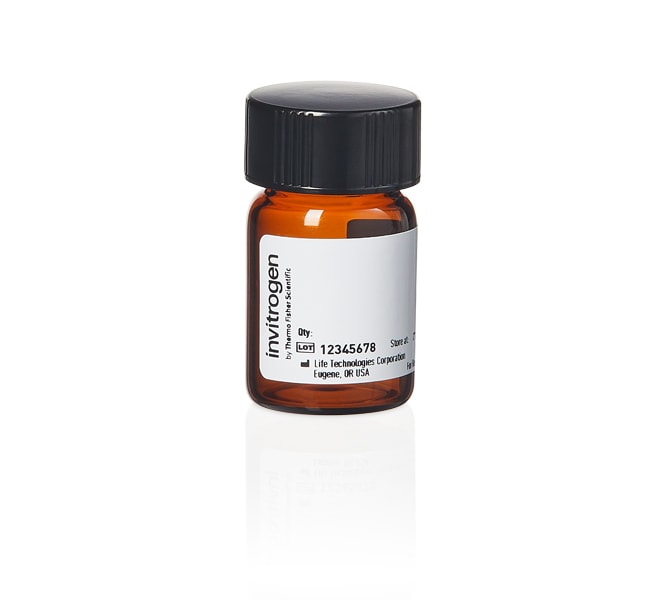Search Thermo Fisher Scientific

Certificates
SDS
Citations & References (151)
Invitrogen™
CPM (7-Diethylamino-3-(4'-Maleimidylphenyl)-4-Methylcoumarin)
The thiol-reactive coumarin, CPM is very weakly fluorescent until reacted with thiols producing a conjugate with excitation/emission maxima of ∼384/470Read more
| Catalog Number | Quantity |
|---|---|
| D346 | 25 mg |
Catalog number D346
Price (EUR)
798,00
Each
-
Quantity:
25 mg
Price (EUR)
798,00
Each
The thiol-reactive coumarin, CPM is very weakly fluorescent until reacted with thiols producing a conjugate with excitation/emission maxima of ∼384/470 nm.
For Research Use Only. Not for use in diagnostic procedures.
Specifications
Chemical ReactivityThiol
Emission470 nm
Excitation384 nm
Label or DyeMethylcoumarin
Product TypeCPM
Quantity25 mg
Reactive MoietyMaleimide
Shipping ConditionRoom Temperature
Label TypeClassic Dyes
Unit SizeEach
Contents & Storage
Store in freezer (-5°C to -30°C) and protect from light.
Have questions about this product? Ask our AI assisted search.
This is an AI-powered search and may not always get things right. You can help us make it better with a thumbs up or down on individual answers or by selecting the “Give feedback" button. Your search history and customer login information may be retained by Thermo Fisher and processed in accordance with our
Privacy Notice.
Figures

Chemical Structure
Customers who viewed this item also viewed
Documents & Downloads
Certificates
Search by lot number or partial lot number
Lot #Certificate TypeDateCatalog Number(s)
2984223Certificate of AnalysisApr 08, 2025D346
2926473Certificate of AnalysisMay 25, 2024D346
2743063Certificate of AnalysisOct 03, 2023D346
2743063Certificate of AnalysisOct 03, 2023D346
2667584Certificate of AnalysisJun 08, 2023D346
5 results displayed, search above for a specific certificate
Safety Data Sheets
SDS
Product Information
Citations & References (151)
Search citations by name, author, journal title or abstract text
Citations & References
Abstract
Fluorescence resonance energy transfer mapping of the fourth of six nucleotide-binding sites of chloroplast coupling factor 1.
Journal:J Biol Chem
PubMed ID:1832671
Equilibrium dialysis measurements of adenine nucleotide binding to chloroplast coupling factor 1 suggest that the enzyme has six binding sites for ADP, adenylyl-beta,gamma-imidodiphosphate (AMP-PNP), and 2'(3')-O-2,4,6-trinitrophenyl-ATP (TNP-ATP). High affinity binding at all six sites requires the divalent cation, Mg2+. Three of the nucleotide-binding sites, sites 1, 2, and 3, have
Arrangement of the COOH-terminal and NH2-terminal domains of caldesmon bound to actin.
Journal:Biochemistry
PubMed ID:9092808
'Smooth muscle caldesmon is a single polypeptide chain with its NH2- and COOH-terminal domains separated by a long alpha-helix. Caldesmon was labeled at either Cys-153 in the NH2 domain or Cys-580 in the COOH domain with a variety of fluorescence probes. Fluorescence intensity, peak position, and polarization of probes on
The pleckstrin homology domain of phospholipase Cbeta transmits enzymatic activation through modulation of the membrane-domain orientation.
Journal:Biochemistry
PubMed ID:16669615
'Phospholipase Cbeta (PLCbeta) enzymes are activated by Galpha q and Gbetagamma subunits and catalyze the hydrolysis of the minor membrane lipid phosphatidylinositol 4,5-bisphosphate [PI(4,5)P2]. Activation of PLCbeta2 by Gbetagamma subunits has been shown to be conferred through its N-terminal pleckstrin homology (PH) domain, although the underlying mechanism is unclear. Also
Structural organization of chloroplast coupling factor.
Journal:Biochemistry
PubMed ID:2859887
'Fluorescence resonance energy transfer measurements have been used to construct spatial maps for the accessible sulfhydryl of the gamma subunit (dark site) and the essential tyrosine residue of the beta subunits relative to previously mapped sites on the H+-ATPase from chloroplasts. The extent of energy transfer was measured between a
Signaling through a G Protein-coupled receptor and its corresponding G protein follows a stoichiometrically limited model.
Journal:J Biol Chem
PubMed ID:17420253
'The bradykinin receptor is a G protein-coupled receptor (GPCR) that is coupled to the Galpha(q) family of heterotrimeric G proteins. In general, a GPCR can exert intracellular signals either by transiently associating with multiple diffusing G protein subunits or by activating a G protein that is stably bound to the
151 total citations